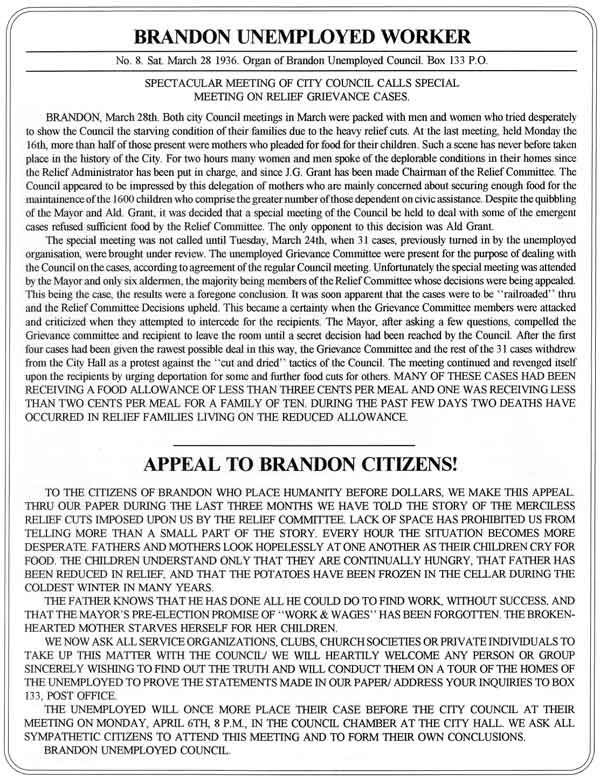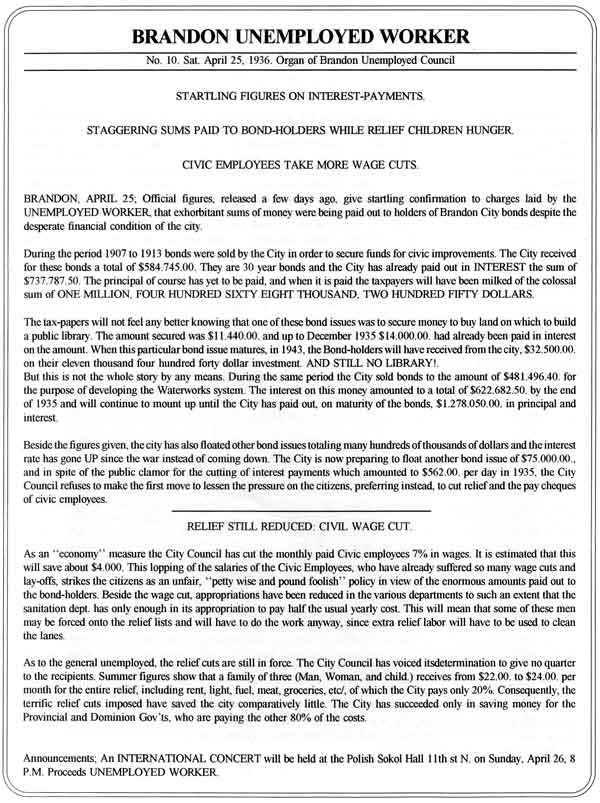by Donica Belisle
Brandon University
Number 36, Autumn/Winter 1998-1999
|
In 1931 the Brandon Unemployed Council was created in Brandon. [1] Led by local members of the Communist Party, it was designed to organize and to assist the growing numbers of jobless workers in the city. Throughout the thirties it was a highly visible and active organization. By the middle of the decade two thousand people were estimated to be members of the Council. [2] In December 1935, the Council’s executive committee initiated the publication of a bi-monthly newsletter called the Brandon Unemployed Worker. Designed to compete with the conservative Brandon Daily Sun in shaping the debate on the treatment of the unemployed in Brandon, the Worker appealed to “all citizens who are in favour of granting the most maligned section of the community A Square Deal. [3] Unlike the Sun, which supported the municipal government’s decisions and policies, the Worker criticized various actions of the City Council. The Brandon Unemployed Worker also had an educative and organization function for the unemployed. It provided a forum for the consideration and advocacy of alternative, practical solutions to the economic crisis of the depression.
Stan Forkin, Editor of the Brandon Unemployed Worker.
Source: Errol Black, Brandon University
The inadequacy of relief provided by the City was a central theme of the Unemployed Worker. Many reports of Brandon’s inadequate relief situation were published in the Worker. In January 1936, a reporter complained that property-owning people in Brandon were refused relief if they had not been in the city for a year. [4] As well, the Worker stated that the average meal value for those on relief was two to three cents. In comparison, Saskatchewan “PAYS FIVE CENTS PER MEAL FOR THE PRISONERS IN HER JAILS.” [5] The editors directly addressed the readers, saying, “We maintain the present relief allowances, averaging 2½ to 3 cents per meal ..., is not enough to maintain growing children, despite every sacrifice the parents make.” [6]
While bringing the severity of the relief problem to the public’s attention, the Worker also demonstrated to those readers who were on relief that there were solutions to their problems. It continually argued that “the first duty of any municipal council is to provide for the people of the city.” [7] Proposals for new relief funding were suggested. In February 1936, the Worker reported that “THE INTEREST RATE (on city bonds) WHICH HAS REMAINED THE SAME ALL THROUGH THE DEPRESSION IS THE ONLY PLACE ... WHERE FURTHER REDUCTIONS CAN BE MADE.” [8] The reader’s attention was drawn to the city government of Calgary which was “contemplating the interest rate on City Bonds” in order to pay relief. [9]
The Worker also reported on the activities of the Brandon Unemployed Council. It portrayed the actions of the Unemployed Council in sympathetic terms. Frequently these reports provided direct comparison of the actions of the Unemployed Council with those of City Council. In the issue of 4 January, for instance, it was reported that an unemployed delegation appeared before the mayor on Sat. 21. The mayor and Mr. Rumball, relief administrator, bitterly protested the crowding of the ... City Hall by masses of ragged and hungry citizens. [10]
Reports such as this one demonstrated to the newsletter’s readers that the City Council was unfair in its treatment of relief recipients. Furthermore, readers were encouraged to attend the Unemployed Council meetings and accompany its members to the City Council meetings so that they could learn more about their precarious situation in the capitalist economy.
Although the Worker ceased publication in June of 1936, its contributions to the political education of its audience were significant. Readers were informed that there were alternative solutions to their existing economic crisis. They were also exposed to a different political agenda than that espoused by the Brandon Daily Sun. Appealing to those who were most affected by the depression, the Brandon Unemployed Worker contributed to the creation of a new critical consciousness among the city’s jobless workers in the midst of the Great Depression.
Unemployed workers ride the rails in 1935 as part of the “On To Ottawa” trek.
Source: Toronto Star Collection
1. McKee Archives, Brandon University, RCMP Files, #96-A-00078, p.1663.
2. Brandon Unemployed Worker, 14 March, 1936.


Page revised: 13 March 2011